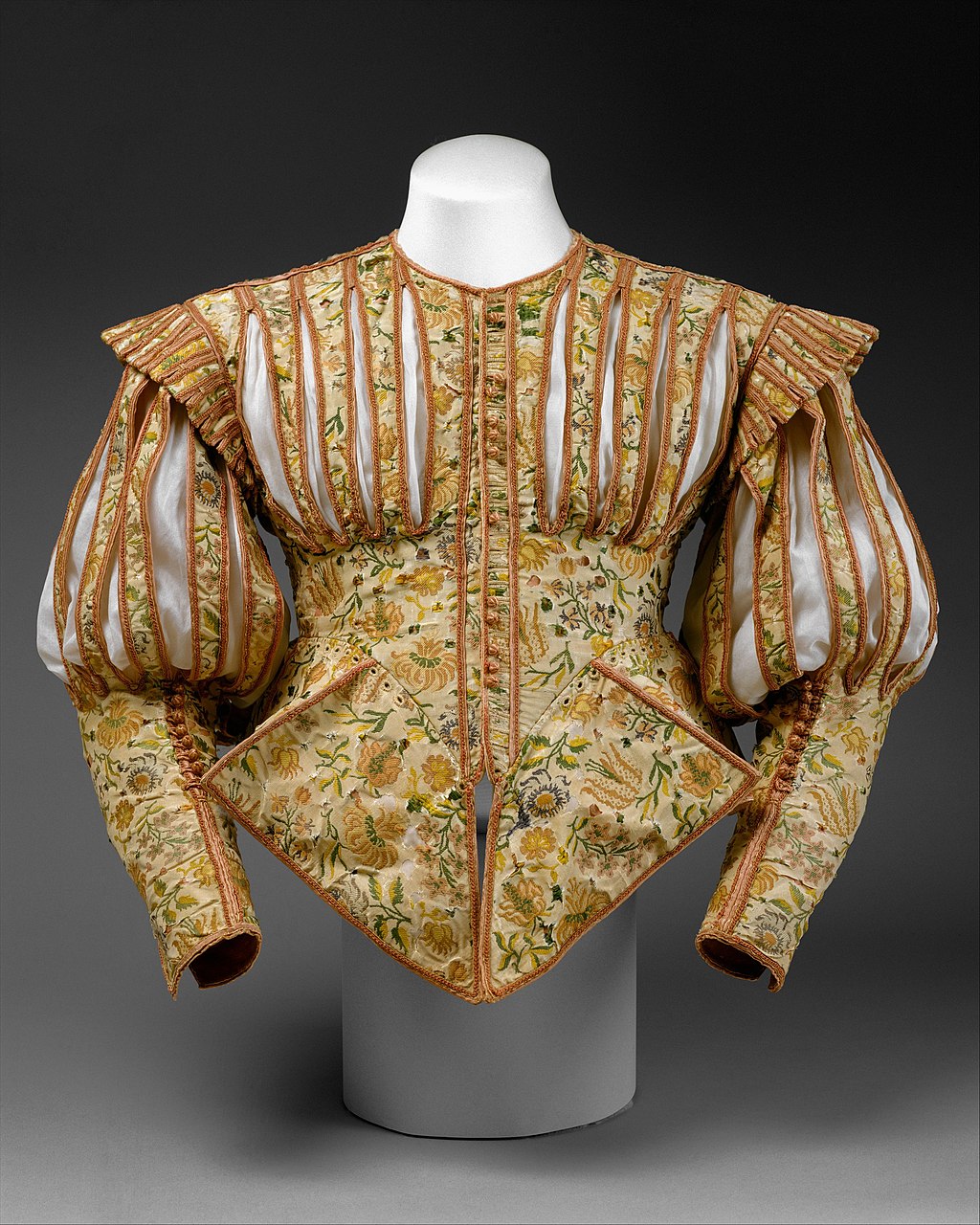
This man’s doublet is from the 1620s and is made of luxurious silk embellished with pinking and decorative slits. A doublet was a man’s snug-fitting jacket that is shaped and fitted to the man’s body.
Pinking was the intentional slashing of fabric and was used as a decorative technique to show colorful linings and shirts. The doublet had a long history of over 300 years with a variety of styles and cuts.
The doublet was usually worn under another layer of clothing such as a gown when in public. Initially, it was just stitched and quilted lining, which was worn under a piece of armor consisting of breastplate and backplate and used to prevent bruising and chafing.
Later it became elaborated enough to be seen on its own. Throughout its long history, the doublet served to give an elegant shape and padding to the body.
Doublets of the 14th and 15th centuries were generally hip-length, sometimes shorter, worn over the shirt. From the late 14th century, doublets were cut and padded to give the wearer a pigeon-breasted silhouette, a fashion that gradually died out in favor of a flatter natural fit.
Through the Tudor period, fashionable doublets remained close-fitting with baggy sleeves, and elaborate surface decoration such as pinks, slashes, embroidery, and applied braid.
In the early Elizabethan period, doublets were padded over the belly with sleeve attachments at the shoulder. By the 17th century, doublets were short-waisted. A typical sleeve of this period was full and slashed to show the shirt beneath.
Decorative ribbon points were pulled through eyelets on the breeches and the waist of the doublet to keep the breeches in place and were tied in elaborate bows.
The doublet fell out of fashion in the mid-17th century when Louis XIV of France and Charles II of England established a court costume for men consisting of a long coat, a waistcoat, a cravat, and breaches. The ancestor of the modern suit.
Doublet
- Title: Doublet
- Date: Early 1620s
- Geography: French
- Materials: Silk
- Museum: Metropolitan Museum of Art – MET
The Art of Power Dressing in the 16th Century
Explore the Metropolitan Museum of Art
MET European Paintings Collection
- “Pygmalion and Galatea” by Jean-Léon
- “Saint Jerome as Scholar” by El Greco
- “Portrait of Juan de Pareja” by Diego Velázquez
- “Camille Monet on a Garden Bench” by Claude Monet
- “View of Toledo” by El Greco
- “The Musicians” by Caravaggio
- “The Death of Socrates” by Jacques-Louis David
- “The Harvesters” by Pieter Bruegel the Elder
- “Young Woman Drawing” by Marie-Denise Villers
- “The Grand Canal, Venice” by J. M. W. Turner
- “The Houses of Parliament (Effect of Fog)” by Claude Monet
- “Madame Cézanne in a Red Dress” by Paul Cézanne
MET Modern and Contemporary Art Collection
- “Reclining Nude” by Amedeo Modigliani
- “Improvisation 27 (Garden of Love II)” by Wassily Kandinsky
- “Jeanne Hébuterne” by Amedeo Modigliani
- “The Card Players” by Paul Cézanne
- “Bathers” by Paul Cézanne
MET Greek and Roman Art Collection
- Statue of a Kouros
- Amathus Sarcophagus
- Mycenaean Terracotta Female Figures
MET Egyptian Art Collection
- The Temple of Dendur
- The Sphinx of Hatshepsut
- William the Faience Hippopotamus
MET Asian Art Collection
- Luohan – Yixian Glazed Ceramic Sculpture
- Pillow with Landscape Scenes – Zhang Family Workshop
- Jar with Dragon
MET Ancient Near Eastern Art Collection
- Sumerian Standing Male Worshiper
- Head of a Beardless Royal Attendant – Eunuch
- Human-Headed Winged Bull (Lamassu)
MET American Wing Collection
- “Washington Crossing the Delaware” by Emanuel Leutze
- “Portrait of Madame X” by John Singer Sargent
- “Mother and Child” by Mary Cassatt
- “Fur Traders Descending the Missouri” by George Caleb Bingham
- “The Gulf Stream” by Winslow Homer
MET Islamic Art Collection
- Blue Qur’an
- Marble Jar of Zayn al-Din Yahya Al-Ustadar
- The Damascus Room
MET Arts of Africa, Oceania, and the Americas Collection
- Benin Ivory Mask
- African Face Mask – Kpeliye’e
- Sican Funerary Mask – Peru
- Ceremonial Axe – Papua New Guinea
MET European Sculpture and Decorative Arts Collection
- “Hercules the Archer” by Antoine Bourdelle
- “Orpheus and Eurydice” by Auguste Rodin
- “Perseus with the Head of Medusa” by Antonio Canova
MET Medieval Art Collection
- “The Last Supper” by Ugolino di Nerio
- Plaque with the Journey to Emmaus and Noli Me Tangere
- Doorway from the Church of San Nicolò, San Gemini
MET Drawings and Prints Collection
- Album of Tournaments and Parades in Nuremberg
- “Canvassing for Votes” by William Hogarth
- “Christ and the Woman of Samaria” by Rembrandt
MET Costume Institute Collection
- Bodice
- Cardinal Cape
- Doublet
MET Arms and Armor Collection
- Blade and Mounting for a Sword (Katana)
- Double-Barreled Flintlock Shotgun
MET Photograph Collection
- Loie Fuller Dancing
- Sala Delle Statue, Vatican
- Gardner’s Photographic Sketchbook of the War
MET Musical Instrument Collection
- Ming-Dynasty Pipa
- Grand Piano
- Bass Fluegel Horn in B-flat
Explore the MET
- The MET Cloisters
- Met Breuer
- Metropolitan Museum of Art – MET
Why I dress as a gentleman… everyday of my life
Joined Hose and Doublet
Getting Dressed in the 18th Century – Men
~~~
“The best things in life are free.
The second best are very expensive.”
– Coco Chanel
~~~
Photo Credit: 1) Metropolitan Museum of Art [CC0], via Wikimedia Commons
Popular this Week








 Sponsor your Favorite Page
Sponsor your Favorite Page SEARCH Search for: Search Follow UsJoin – The JOM Membership Program
Sponsor a Masterpiece with YOUR NAME CHOICE for $5
Share this:
- Tweet
